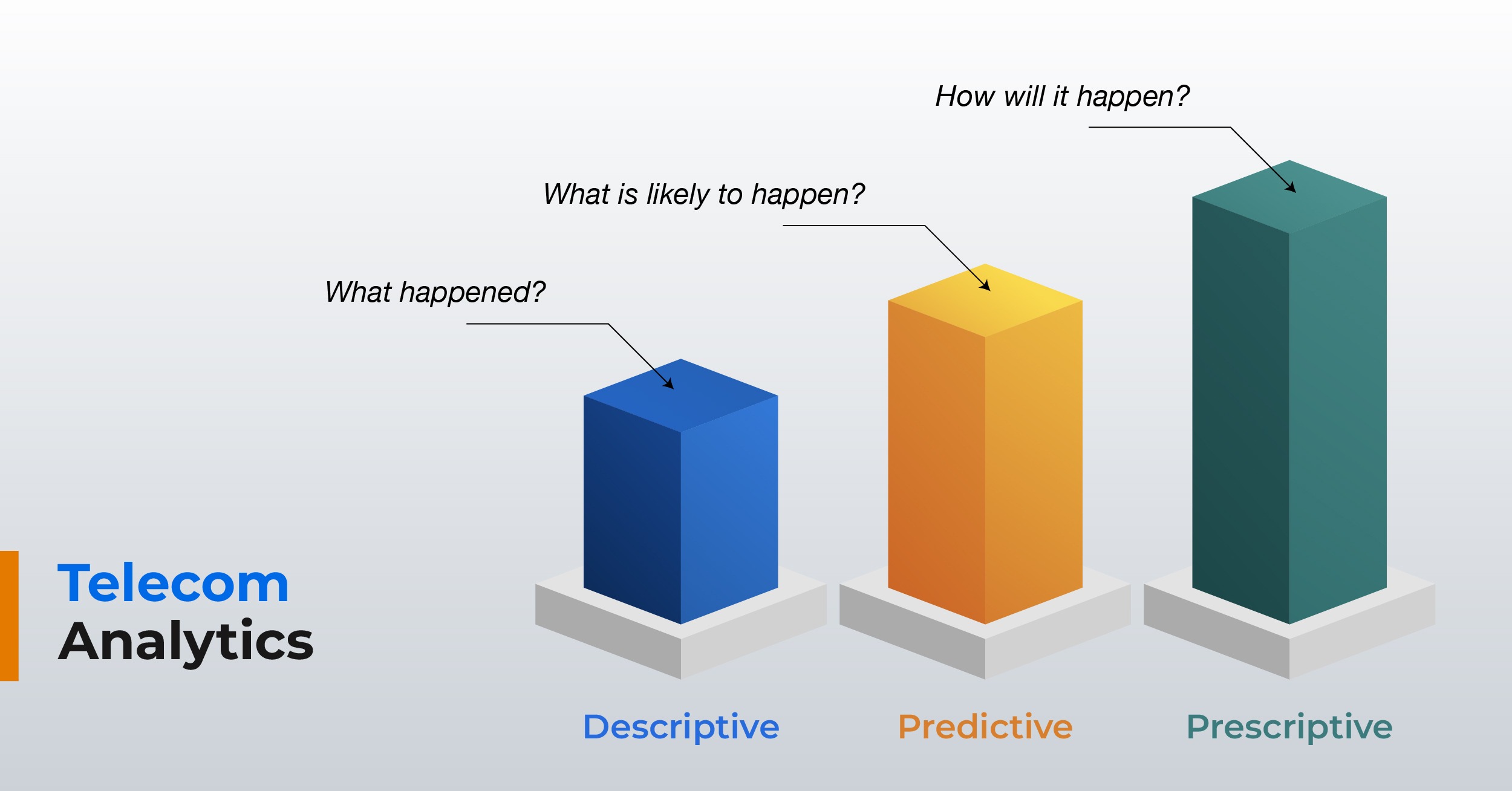Looking at the current trends, it’s clear that big data is gaining traction rapidly in the telecom industry compelling telecom CIOs to focus on making analytics a core part of their business strategy. With more information at their disposal, telecom leaders can now utilize prescriptive analytics to drive innovation forward which is what this article details further.
Many telcos have realized that their data delivers massive potential for actionable and real-time insights and have begun implementing big data analytics in their operations. Doing this helps telcos reap benefits like optimized decision-making, improved customer service, increased ARPU, reduced churn, and efficient internal operations to name a few.
The Telecom Revenue-Growth Newsletter
Our coveted monthly newsletter compiles vetted insights on creating effective sales and distribution chains that fulfil telcos' revenue goals. That, and a lot more.
Here’s a list of what will be covered in this blog:
Telecom Analytics: the journey from descriptive to prescriptive analytics
Most of the big data analytics used by organizations is descriptive, which involves studying past performance in order to learn from it.

Descriptive analytics
Descriptive analytics help telcos understand the behavioral patterns of customers. This enables them to gain insight into what action to take for improvement in the future.
Telcos use descriptive analytics to gain insights into their subscribers’ usage patterns and behaviors. To get this visibility, MNOs can use field force optimization tools with the easy-to-use monitoring and exploration of data and use those insights to make informed decisions.
A competent tool like Smart S&D analyzes subscribers’ historical consumption patterns, helping telcos to predict what their customers might buy in the future. Although, with the way the telecom ecosystem is evolving, keeping track of previous consumption patterns to create reports and dashboards is not enough to secure a competitive edge.
Predictive analytics
Predictive analytics goes one step further by analyzing historical trends and patterns and finding out what the future outcome could be. Telcos can implement prediction models in different areas to increase ARPU by predicting and identifying which subscribers have the potential to purchase a new device (and upgrade them to a higher technology) or by predicting the probability of churn, based on past customer behavioral patterns.
Telcos can use their prediction model in different areas of the business to forecast customers’ future buying patterns.
- Probability of customer churn – predicts the probability that a customer will churn within a particular time span with higher accuracy than is possible based on past behavioral patterns—helping Telcos reduce losses. The model should be able to categorize subscribers based on the degree of risk associated with them.
- Probability of customer purchase – predicts and identifies the telecom subscribers who are likely to purchase devices, activate applications, or subscribe to service plans within a given period of time
In order to overcome competition, OpCos need to adopt tools that leverage richer insights, which is where prescriptive analytics comes for help.
Prescriptive analytics
As a natural progression from descriptive and predictive analytics, prescriptive analytics leaps ahead and removes the guesswork of telecom data analytics. It also allows operators to spend less time understanding their subscriber data and more on delivering a highly personalized experience for customers. To further optimize growth, telcos can use prescriptive analytics to grasp details about their POS performance and act on the POS density to get intuitive recommendations for where to recruit their next POS or how many.
With the help of advanced algorithms and models, prescriptive analytics not only helps to figure out what has happened in the past but also identifies patterns in data with the aim of providing recommendations on how to maximize key business metrics to improve outcomes.
Business benefits of prescriptive analytics:
- Creates a roadmap that tells OpCos what to do and how to do it right the first time
- Allows visibility into real-time and forecasted data simultaneously to make decisions for sustained growth
- Reduces the prospect of human error or bias through accurate and comprehensive data aggregation
The problems that can be solved with prescriptive analytics
Network Optimization
It goes without saying that telecom operators face the increasing pressure of constantly optimizing networks given the customers’ growing expectations of having fast and uninterrupted connections amidst increasing costs due to underutilized or nearing maximum capacity networks. Network optimization helps in rationalizing/consolidating existing operations thereby, optimizing network builds, reducing outages, improving the customer experience, and simplifying network control and operations.
Data analytics provides the best path to achieving this continuous optimization, as with platforms like Smart Capex, telcos can get recommendations about where to put the next antenna or fiberhood, especially as it uses predictive analytics (churn, ARPU increase, etc.) to predict where an Opco should invest. Smart Capex can also help in determining whether to push to technologies such as 5G in certain areas; depending on if the OpCo wants to have a good signal then that means that they have to push for 5G instead of increasing the capacity of 4G networks.
Prescriptive modeling enables telecom operators to predict the problems that could cause network crashes or interruptions and provides recommendations on how to avoid them. Moreover, due to advanced analytics, telcos can analyze subscriber behavior and create individual network usage policies, receive a 360-degree overview of the network’s health, and optimize their network investment processes.
Operational Excellence
Prescriptive analytics can fundamentally transform the operations of telcos across multiple dimensions. Some of the use cases would include: informing telcos to visit a POS in case of a possible stockout or adding another POS to a certain area as it will bring more revenue.That’s why many telecom operators are turning to integrate advanced analytics solutions in their day-to-day operations, which allows them to optimize their sales and distribution.
What Riaktr brings to the table with advanced analytics solutions
Prescriptive analytics is very versatile, and can help optimize a company’s internal and external processes, improve customer satisfaction, reduce risks, and increase revenues. Our powerful platform MyNextPOS enables telecoms to make data-driven decisions with its user-friendly interface and powerful analytics and allows them to easily identify the untapped areas. Given that it works by analyzing the data related to the sales and foot traffic in each location, and then determines the optimal density of POS systems, this means that telecoms don’t have to waste their resources on areas where the density of POS systems is already sufficient. Instead, they can focus their efforts on the areas that require more POS systems, which in turn helps to maximize their profits.
Telecom operators both in network optimization and operational excellence through prescriptive analytics. With our Telecom CapEx optimization solution telecom operators are able to produce the best investment plan based on advanced machine learning algorithms. With the help of Smart CapEx telcos track the realization of their investment plan and understand how to improve the next waves of their network investments based on past performance.
Smart S&D, on the other hand, helps optimize telco teams’ operations by allowing them to track their field team’s activities and performance, prioritizing actions and tracking their impact, and providing real-time alerts on shops’ stock so the POS is always ready to meet dynamic demand.


